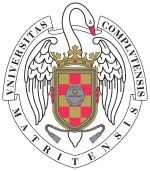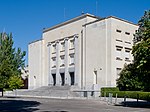The Battle of Ciudad Universitaria was a belligerent confrontation at the start of the defense of Madrid in the Spanish Civil War. This battle happened in the new campus area of the Ciudad Universitaria from the 15 to the 23 of November 1936 (approximately a week) leaving a stable front until the end of the war. The republican militias' objective was "the defense of the capital at all costs", and for that, it was necessary to stop the advance of general Valera's troops and the fall of Madrid. On the other side, the attackers had as an objective to "conquer the city" as fast as possible. The persistence and tenacity of both sides in the battle meant an inflection point on the Spanish Civil War, partly because it was the first time that Franco's troops were stopped. The campus was also one of the most long-lasting confrontation points during the Spanish Civil War. The resistance shown in Madrid raised the morality of other fronts amongst the Gobierno de la República's controlled zone. The end of the battling period on the 23 of November 1936 was because of a change in strategy on part of the attackers. Between the main characteristics of this confrontation, it is worth mentioning the entrance to battle, for the first time in this war, of the varied troops that belonged to the International Brigades, just like the heavy military material of Soviet origins. The attackers received material and troops from Germany and Italy, being also one of the first times in history in which aerial bombing against the civil population was used.
On the 8 of November 1936, general Valera's militarily planned frontal assault started with an initial approach to the Casa de Campo. This attack moved the focal point of the attack to the northeast to occupy the zone between Ciudad Universitaria and Plaza de España. This first frontal attack was very bloody on both sides and made a slow advance amongst the troops that directed the main axis of effort through la Casa de Campo to a stream of the river Manzanares. In this stream, the attackers saw the necessity of advancing through the bridges that were held by the militia troops. After various failed attempts to cross the Manzanares, they get to the other side through the space between two bridges. The battle of Ciudad Universitaria starts on the 15 of November spreading the conflict all throughout the campus. The fierce violence for occupying the city and the determination to stop the advance maintains itself on both sides. Both sides start running out of tactics as the death count goes up and the battle carries out between the faculties and diverse buildings of the campus. This confrontation is characterized by the fight inside the buildings, room by room, floor by floor. After a whole week of intense fighting and slow advance, general Franco has a reunion on the Cuartel General de Leganés, and on the 23 of November, the attackers' strategy changes: they would indirectly attack Madrid with a maneuver on the axis Las Rozas-Húmera (nowadays a neighborhood in Pozuelo de Alarcón) less than 2 kilometers northeast to the campus, which gave way to other battles like the Jarama ( February 1937) and later the Guadalajara (March 1937). The Campus' front was in a wedge form, whose corner was the Clínico, maintaining its lines practically the same during the rest of the Civil War. Even if the front stayed the same, there was a fierce battle in the Ciudad Universitaria and Parque del Oeste with mines and countermines, all with unsuccessful infantry offensives until on the 28 of March 1939 the coronel Segismundo Casado surrendered the city to the attacking troops.
After the dispute, the campus of the Ciudad Universitaria and the adjacent parts of the city was left very damaged. Ironically, the buildings were not used for the first time as a university, but as a war front. It was not until some years later that it was possible to recover normal docent activities in some faculties. The state in which the campus was left made the idea of a thematic park of the Civil War be established there, but the idea led to nothing in the end. The war caught the University in the middle of a changing state since many of the faculties that were in the urban center were going to rejoin slowly in the newly built campus. The war came unexpectedly and they were used in combats instead of studying places. The reconstruction of the faculties led that on the 12 of October 1943 the new precinct was inaugurated, starting the academic year. There were also built monuments dedicated to the commemoration of the victory of Franco's army, for example, the Arco de la Victoria built from 1950 to 1956 or the Monumento a Los Caídos Por España (nowadays the headquarters of the Junta Municipal del Distrito de Moncloa-Aravaca). The scars that the battle left have been hidden by the reconstruction of the faculties, the reconstruction of the surroundings Moncloa-Aravaca and the consequences of the urbanistic expansion of the '70s, just as remodeling projects like the burying of the M-30 and the creation of parks at the shore of the Manzanares like Madrid Río.










